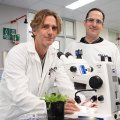Brisbane's Inner City Renaissance
An inner-city renaissance is occurring in many of Brisbane's inner-city areas according to a new report by researchers at The University of Queensland to be launched at a joint Brisbane Development Association and Brisbane Institute launch tomorrow Thursday August 10.
After several decades of population decline, the inner suburbs are attracting people back to live, with some areas experiencing growth of over 25 per cent in the last 10 to 15 years. But this growth is focused strongly on the 20 to 54 year age groups, and in particular students, young professional workers, and middle-aged professionals.
"A major driver of inner-city transformation is the rapid growth in new economy jobs in the advanced business services, information technology, education and health that are highly concentrated in the CBD, nearby business districts like the Coronation Drive strip, and an arc that runs from Herston through Indooroopilly and St Lucia to South Brisbane," said Professor Bob Stimson and Dr Pat Mullins, who led the research team.
"A further driving force is the attraction of the inner-city as a place of consumption oriented to the needs of the professionals and managers, plus tertiary students, who are attracted to the lifestyle provided by the inner-city."
The early phases of inner-city transformation actually started in the 1970s with the gentrification of localities such as Spring Hill and Paddington when middle class professionals moved in to renovate the old timber and tin workers cottages. During the 1980s and 1990s there was a spread of gentrification more widely across the inner-city suburbs. But a new feature of this second phase has been an increasing emphasis on urban renewal projects and the redevelopment of older housing.
As a result the inner city have seen a marked change in the character of their housing, away from traditional stand-alone houses to apartments. Associated with this has been a shift away from home ownership to private rental.
The report also points to the substantial role governments have been playing in the transformation of the inner-city.
Governments at all levels have been active in encouraging urban consolidation. This is seen in various forms, including Brisbane City Council encouraging in-fill housing development, and the master-planned redevelopment of the inner north-eastern suburbs led by the Urban Renewal Task Force with its redevelopment projects that include conversion of the Teneriffe Woolstores to housing and the construction of major new medium density apartment projects.
The State Government has also been actively involved in what the report calls ?urban boosterism'. The last 20 years have seen mega projects like the South Bank Arts precinct, South Bank Parklands, the Convention Centre, and the Treasury Casino. Recent mega projects announced include the Roma Street Railyard redevelopment-the City West precinct-and the Lang Park super stadium project.
Public transport has been a particular focus of planning in the inner-city, including busways, the city to airport rail link, the Inner City Bypass, and the recently aborted light rail project.
Over the ten years to 1998, Brisbane's inner-city suburbs were the target for over $1.4 billion public sector investment in new construction. And the inner-city suburbs-including the CBD-attracted more than 2.6 billion invested from the private sector, including $1.2 billion in office construction. More than $830 million was invested in education and health facility construction.
The report shows how Brisbane's inner-city suburbs provide about one-third of the total jobs in the South East Queensland. It is anticipated by the year 2011 that the CBD and the surrounding 16 suburbs will have around 255,000 even though the proportion of the SEQ regions jobs in the inner-city areas will continue to decline.
According to the report's authors, three key policy issues arise from the transformations occurring in the inner-suburbs.
First, there is a social equity issue through the displacement of lower-income households, the aged and the families with young children to the outer suburbs with their poorer levels of services such as public transport. Providing affordable housing for low-income groups in the inner-city will become a bigger problem as land and housing prices continue to increase at rates well above the outer suburbs.
Second, greater levels of investment in both public transport and new road systems, including a fully connected inner-city freeway loop both with connections to growth corridor freeways, will be needed to cope with the projected increased passenger and freight traffic into and passing through the inner-city areas.
Third, more emphasis on large scale area urban renewal planning will be needed across the inner-city if urban consolidation and renewal is to have a substantial impact stemming the rate of outer suburban growth. This will require greater public sector led intervention. The report suggests the wider adoption of the Urban Renewal Task Force model that is having considerable success in the renewal and redevelopment of the inner north-east suburbs.
The Inner City Renaissance report is available on CDRom from The University of Queensland Bookshop, Tel. 3365 2438.
Contact:
Professor Bob Stimson
Tel: (07) 3365 6307 (work)
Mobile: 0411-020627
Tel: (07) 3379 8542 (home)
Enquiries can also be directed to communications@mailbox.uq.edu.au
.jpg)



